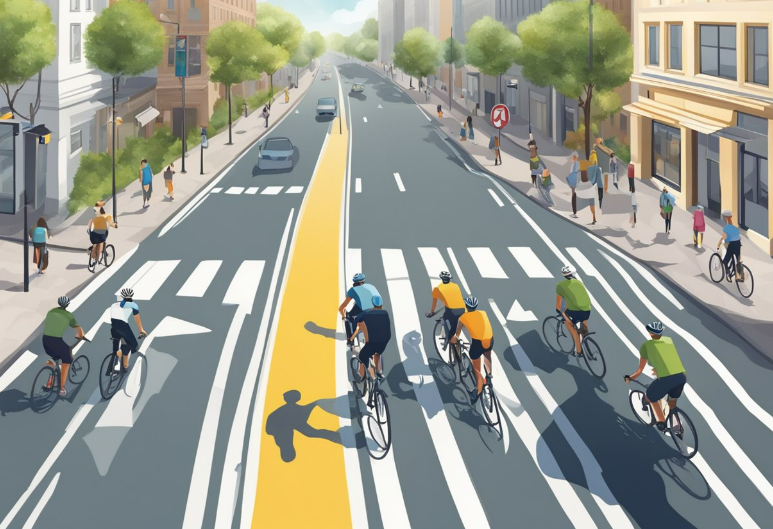Essential Cycling Etiquette Guidelines for a Safe and Respectful Ride
Cycling is more than just an individual pursuit; it’s an activity that encompasses a diverse community where respect, safety, and etiquette play pivotal roles. As members of this community, we share the responsibility to foster an environment that is not just safe for ourselves but also for other road users. To achieve this, it's vital to internalize and practice the norms of cycling etiquette, which serve as the unspoken rules of the biking world.
Embracing these guidelines ensures that every ride contributes positively to the collective image of cyclists and enhances the experiences on the road or trail for everyone involved. Our understanding of cycling etiquette extends from the basics of obeying traffic laws to the complexities of group riding dynamics and off-road trail interactions. These nuances of conduct are essential for creating a respectful coexistence and minimizing conflicts or accidents. By regarding ourselves as part of the larger traffic ecosystem, we actively recognize our rights and responsibilities on the road, thereby promoting a culture of mutual respect and awareness.
Key Takeaways
Cycling etiquette is essential for safety and fostering a respectful community.
Visibility and adherence to traffic laws are key for a safe cycling experience.
Respectful interactions with other road users are crucial for a harmonious ride.
Cycling Safety and Visibility on the Road
As we share the roadways, understanding the essentials of cycling safety and visibility is imperative for a safe and respectful riding experience. It’s crucial that we make ourselves visible to other road users and adhere to traffic laws to prevent accidents and ensure a harmonious coexistence with motorists and pedestrians alike.
Understanding and Utilizing Hand Signals
To effectively communicate our intentions on the road, it's essential to use hand signals. Extending our left arm out to signal a left turn and our right arm for a right turn ensures that those around us can anticipate our movements and react accordingly. Similarly, to indicate a stop, we should extend our left arm out with the forearm lowered at a 90-degree angle.
The Importance of Wearing a Helmet and Reflective Clothing
Safety starts with our choice of attire. A properly fitted helmet is non-negotiable—it's our first line of defense in the event of a fall or collision. During low light conditions or at night, wearing reflective clothing or accessories significantly enhances our visibility to others. This can include vests, jackets, or bands placed on our limbs or torso.
Adhering to Traffic Laws and Rules of the Road
We must respect traffic laws and rules of the road just as any vehicle does. This includes obeying stop signs and traffic signals and yielding the right-of-way when appropriate. We occupy the same legal space on the road and thus share the same responsibilities to maintain order and safety.
Using Lights and Reflectors for Nighttime Visibility
To ensure we’re seen at night, equip our bikes with front white lights and rear red lights, as well as additional reflectors. It's also a good strategy to have reflective tape on our bike’s frame or wheels, which moves with us and catches the attention of drivers, further enhancing our visibility.
Interactions with Other Road Users and Trail Etiquette
In sharing roads and trails, we must balance assertiveness with consideration. By maintaining respectful relationships with all road users and following trail etiquette, we contribute to a safer environment for everyone involved.
Maintaining Respect and Courtesy with Pedestrians and Cyclists
When sharing the path with pedestrians, we always yield the right of way. We use clear verbal cues or a bell to signal our approach and pass with abundant space, often at least three feet, to ensure their comfort and safety. Respecting their space aids in fostering a cooperative dynamic between cyclists and walkers.
Communicating Intentions and Avoiding Sudden Movements
Clear communication and predictability are pillars of cycling etiquette. Before turning or changing lanes, it's important we indicate our intentions to those around us—ideally, through both hand signals and verbal cues. We avoid sudden movements like swerving to dodge potholes, ensuring that others can anticipate our actions and prevent accidents.
Navigating Intersections, Roundabouts, and Bike Lanes
Intersections and roundabouts demand heightened vigilance. We adhere to the same rules of the road that govern vehicles, like stopping at red lights and yield signs, to clarify our intentions to motorists. While in bike lanes, we keep to the right and pass on the left only when it's safe, checking over our shoulder and signaling before we maneuver.
At roundabouts: Yield to traffic within the circle and signal our exit.
In bike lanes: Stay alert for vehicles turning across our path and use hand signals when changing position.
Group Riding: Coordination and Etiquette
On a group ride, coordination enhances safety and enjoyment. Riding in a double line is often permissible, but we transition to a single file in tighter spaces and when it facilitates other road users' passing. The lead cyclist points out obstacles, and we maintain steady pacing to avoid half-wheeling and the risk of overlapping wheels. Communication remains key, with the lead riders signaling turns and stops and the group echoing these signals down the line.



